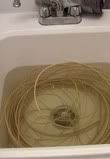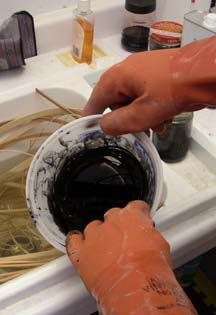Hey Chad,
When MY wife read your post, she pointed out two typos in my original. Oh well, I guess we all have our talents.
Okay, the first thing to do after buying the material, is to prepare the amount that you need. For this quiver, we'll use eleven 25" uprights of 3/8" half oval. Since ten of them are symetrical, we can combine them into five, 50" pieces, plus one 25" piece. You always need an odd number.
Determine the amount of flat, round, and cane material you need according to whatever pattern you've chosen. I usually guess on the long side, as the the stuff's cheap enough, and it's a pain to prepare more if you come up short.
Put all the material in a tub or sink and soak it in hot water. How long depends on your reed, your water and the temperature. Go eat lunch or prepare your stains while the reed softens. Be sure to allow enough time, the reed is very brittle when dry, and soaks up a lot of water. You can't overdo this step, so take your time

The stains I use are water based analine dyes available at any woodworking store, or online from Rockler, or Woodcrafter. I use the water based because I think they have a more muted color than the alcohol based dyes.
Alcohol based dyes are more color fast, and a whole lot easier to use because they don't bleed as much when working the wet reed. I just can't get used to their vibrant color. It seems to me that an accessory used in the woods should have a woodland color and not some brilliant eye popping hue that looks out of place.
Okay, enough soapbox. Use alcohol based dyes, and save yourself some hassles. Maybe I just need to learn to mix them better.
Dye the reed you want for color. I put mine in the microwave to heat it up a bit and it seems to make the water based dyes penetrate better. I'm not sure I'd try that with the alcohol based dye, it probably doesn't need it anyway.

Oh yeah, wear gloves, or you'll have the dye bleeding out of your fingers when you handle the reed, and then you will really have a mess.
Tom




















